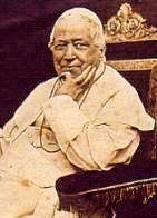 The cardinals, who felt that Gregory XVI had been a little severe, fixed their eyes on the amiable Cardinal Mastai-Ferretti, but the Austrians also had their eyes on him--cold eyes. Austria's representative Cardinal Gaysruck reached the conclave with a veto for Mastai-Ferretti, but it was too late. He had already been elected and had chosen the name Pius IX.
The cardinals, who felt that Gregory XVI had been a little severe, fixed their eyes on the amiable Cardinal Mastai-Ferretti, but the Austrians also had their eyes on him--cold eyes. Austria's representative Cardinal Gaysruck reached the conclave with a veto for Mastai-Ferretti, but it was too late. He had already been elected and had chosen the name Pius IX.
Giovanni Mastai-Ferretti was born at Sinigaglia on May 13, 1792. Refused admission to the pope's noble guards because of epileptic attacks, he turned to the study of theology, and when his epilepsy passed away, Giovanni was ordained a priest. In 1823 he accompanied the apostolic delegate to Chile, and thus became the first pope to have visited the new world. As archbishop of Spoleto, he handled the revolt of 1831 with kind diplomacy. He persuaded the rebels to down arms and the avenging Austrians to be merciful. Transferred to Imola in 1832, he became a cardinal in 1840.
Pius IX at once started to live up to his liberal reputation. He promptly issued an amnesty for political prisoners and made numerous reforms in the Papal States. The delighted Romans took the horses from his carriage to pull it themselves, while girls strewed flowers in the way. But, however numerous his concessions, they were not sufficient to please the radicals, and when Pius refused to join the war against Austria in stormy forty- eight, his popularity plummeted. On November 15 the radicals stabbed the Pope's prime minister, Rossi, and practically besieged Pius himself. Disgusted, Pius fled to Gaeta, leaving Mazzini and his minions to take over at Rome. In 1849 a French army restored papal authority in Rome, and in 1850 back came Pius IX, thoroughly cured of liberalism.
The restoration was not to last. In 1860 Cavour and Garibaldi wrested most of the Papal States from Pius, and in 1870 when the French garrison was withdrawn from Rome, the Piedmontese moved in. Pius, after making a token resistance, confined himself to the Vatican. He refused to accept the situation, and Italo-papal relations remained fundamentally strained until 1929.
If Pius was unfortunate in the temporal sphere, he showed himself a vigorous leader in spiritual matters. In 1854 he declared it a dogma that Mary was conceived without original sin. This was an assertion of papal infallibility and a challenge to a materialistic age which had little belief in original sin. In 1864 Pius issued the encyclical "Quanta cura" and with it a syllabus of seventy errors. This was no sudden whim of the Pope's, but a measure which had been widely discussed and long pondered. Since it was an outspoken and even harsh indictment of many nineteenth- century trends, it caused a sensation. Indeed the syllabus has been an arsenal of anti-Catholic arguments for many who misjudged or misinterpreted it.
The greatest event of the pontificate of Pius IX was the Vatican Council. This, the twentieth ecumenical council, proclaimed as a dogma that the pope when speaking ex cathedra, that is, as pope, can make no mistake in solemn declarations of what must be believed in matters of faith and morals. Pius had to adjourn the council in the summer of 1870 owing to the outbreak of the FrancoPrussian War.
Pius IX died, a very old, tired man, on February 7, 1878.
Excerpted from "Popes
Through the Ages" by Joseph Brusher, S.J.

